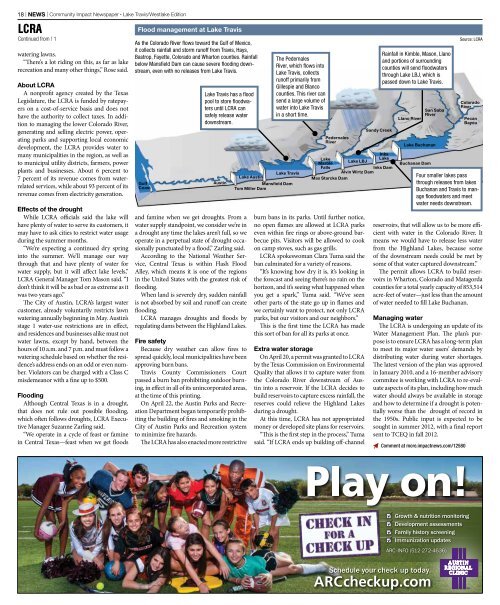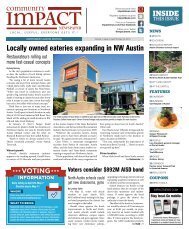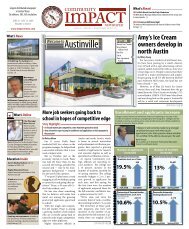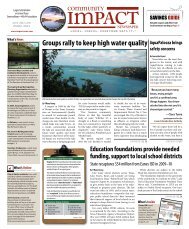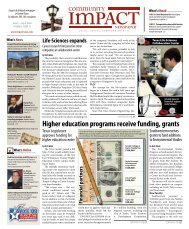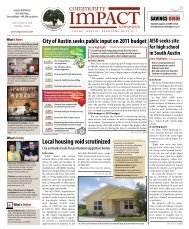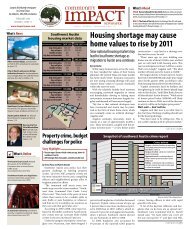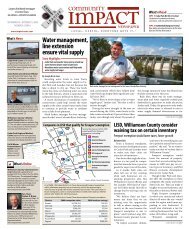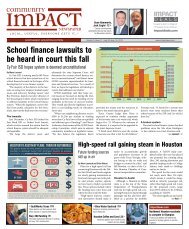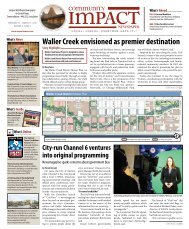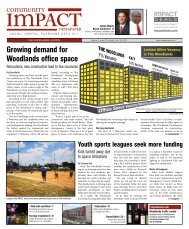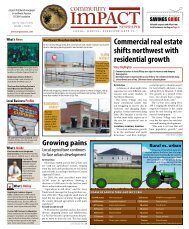City of Lakeway examines new hotel occupancy tax - Community ...
City of Lakeway examines new hotel occupancy tax - Community ...
City of Lakeway examines new hotel occupancy tax - Community ...
Create successful ePaper yourself
Turn your PDF publications into a flip-book with our unique Google optimized e-Paper software.
18 | NEWS | <strong>Community</strong> Impact Newspaper • Lake Travis/Westlake Edition<br />
LCRA<br />
Continued from | 1<br />
watering lawns.<br />
“There’s a lot riding on this, as far as lake<br />
recreation and many other things,” Rose said.<br />
About LCRA<br />
A nonpr<strong>of</strong>it agency created by the Texas<br />
Legislature, the LCRA is funded by ratepayers<br />
on a cost-<strong>of</strong>-service basis and does not<br />
have the authority to collect <strong>tax</strong>es. In addition<br />
to managing the lower Colorado River,<br />
generating and selling electric power, operating<br />
parks and supporting local economic<br />
development, the LCRA provides water to<br />
many municipalities in the region, as well as<br />
to municipal utility districts, farmers, power<br />
plants and businesses. About 6 percent to<br />
7 percent <strong>of</strong> its revenue comes from waterrelated<br />
services, while about 93 percent <strong>of</strong> its<br />
revenue comes from electricity generation.<br />
Effects <strong>of</strong> the drought<br />
While LCRA <strong>of</strong>ficials said the lake will<br />
have plenty <strong>of</strong> water to serve its customers, it<br />
may have to ask cities to restrict water usage<br />
during the summer months.<br />
“We’re expecting a continued dry spring<br />
into the summer. We’ll manage our way<br />
through that and have plenty <strong>of</strong> water for<br />
water supply, but it will affect lake levels,”<br />
LCRA General Manager Tom Mason said. “I<br />
don’t think it will be as bad or as extreme as it<br />
was two years ago.”<br />
The <strong>City</strong> <strong>of</strong> Austin, LCRA’s largest water<br />
customer, already voluntarily restricts lawn<br />
watering annually beginning in May. Austin’s<br />
stage 1 water-use restrictions are in effect,<br />
and residences and businesses alike must not<br />
water lawns, except by hand, between the<br />
hours <strong>of</strong> 10 a.m. and 7 p.m. and must follow a<br />
watering schedule based on whether the residence’s<br />
address ends on an odd or even number.<br />
Violators can be charged with a Class C<br />
misdemeanor with a fine up to $500.<br />
Flooding<br />
Although Central Texas is in a drought,<br />
that does not rule out possible flooding,<br />
which <strong>of</strong>ten follows droughts, LCRA Executive<br />
Manager Suzanne Zarling said.<br />
“We operate in a cycle <strong>of</strong> feast or famine<br />
in Central Texas—feast when we get floods<br />
Flood management at Lake Travis<br />
As the Colorado River flows toward the Gulf <strong>of</strong> Mexico,<br />
it collects rainfall and storm run<strong>of</strong>f from Travis, Hays,<br />
Bastrop, Fayette, Colorado and Wharton counties. Rainfall<br />
below Mansfield Dam can cause severe flooding downstream,<br />
even with no releases from Lake Travis.<br />
Gulf<br />
Coast<br />
Lake Travis has a flood<br />
pool to store floodwaters<br />
until LCRA can<br />
safely release water<br />
downstream.<br />
Austin<br />
and famine when we get droughts. From a<br />
water supply standpoint, we consider we’re in<br />
a drought any time the lakes aren’t full, so we<br />
operate in a perpetual state <strong>of</strong> drought occasionally<br />
punctuated by a flood,” Zarling said.<br />
According to the National Weather Service,<br />
Central Texas is within Flash Flood<br />
Alley, which means it is one <strong>of</strong> the regions<br />
in the United States with the greatest risk <strong>of</strong><br />
flooding.<br />
When land is severely dry, sudden rainfall<br />
is not absorbed by soil and run<strong>of</strong>f can create<br />
flooding.<br />
LCRA manages droughts and floods by<br />
regulating dams between the Highland Lakes.<br />
Fire safety<br />
Because dry weather can allow fires to<br />
spread quickly, local municipalities have been<br />
approving burn bans.<br />
Travis County Commissioners Court<br />
passed a burn ban prohibiting outdoor burning,<br />
in effect in all <strong>of</strong> its unincorporated areas,<br />
at the time <strong>of</strong> this printing.<br />
On April 22, the Austin Parks and Recreation<br />
Department began temporarily prohibiting<br />
the building <strong>of</strong> fires and smoking in the<br />
<strong>City</strong> <strong>of</strong> Austin Parks and Recreation system<br />
to minimize fire hazards.<br />
The LCRA has also enacted more restrictive<br />
Lake Travis<br />
Lake Austin<br />
Mansfield Dam<br />
Tom Miller Dam<br />
The Pedernales<br />
River, which flows into<br />
Lake Travis, collects<br />
run<strong>of</strong>f primarily from<br />
Gillespie and Blanco<br />
counties. This river can<br />
send a large volume <strong>of</strong><br />
water into Lake Travis<br />
in a short time.<br />
Pedernales<br />
River<br />
Lake<br />
Marble<br />
Falls<br />
Max Starcke Dam<br />
Lake LBJ<br />
burn bans in its parks. Until further notice,<br />
no open flames are allowed at LCRA parks<br />
even within fire rings or above-ground barbecue<br />
pits. Visitors will be allowed to cook<br />
on camp stoves, such as gas grills.<br />
LCRA spokeswoman Clara Tuma said the<br />
ban culminated for a variety <strong>of</strong> reasons.<br />
“It’s knowing how dry it is, it’s looking in<br />
the forecast and seeing there’s no rain on the<br />
horizon, and it’s seeing what happened when<br />
you get a spark,” Tuma said. “We’ve seen<br />
other parts <strong>of</strong> the state go up in flames and<br />
we certainly want to protect, not only LCRA<br />
parks, but our visitors and our neighbors.”<br />
This is the first time the LCRA has made<br />
this sort <strong>of</strong> ban for all its parks at once.<br />
Extra water storage<br />
On April 20, a permit was granted to LCRA<br />
by the Texas Commission on Environmental<br />
Quality that allows it to capture water from<br />
the Colorado River downstream <strong>of</strong> Austin<br />
into a reservoir. If the LCRA decides to<br />
build reservoirs to capture excess rainfall, the<br />
reserves could relieve the Highland Lakes<br />
during a drought.<br />
At this time, LCRA has not appropriated<br />
money or developed site plans for reservoirs.<br />
“This is the first step in the process,” Tuma<br />
said. “If LCRA ends up building <strong>of</strong>f-channel<br />
Sandy Creek<br />
Inks Dam<br />
Alvin Wirtz Dam<br />
Rainfall in Kimble, Mason, Llano<br />
and portions <strong>of</strong> surrounding<br />
counties will send floodwaters<br />
through Lake LBJ, which is<br />
passed down to Lake Travis.<br />
Inks<br />
Lake<br />
Llano River<br />
Buchanan Dam<br />
San Saba<br />
River<br />
Lake Buchanan<br />
Four smaller lakes pass<br />
through releases from lakes<br />
Buchanan and Travis to manage<br />
floodwaters and meet<br />
water needs downstream.<br />
reservoirs, that will allow us to be more efficient<br />
with water in the Colorado River. It<br />
means we would have to release less water<br />
from the Highland Lakes, because some<br />
<strong>of</strong> the downstream needs could be met by<br />
some <strong>of</strong> that water captured downstream.”<br />
The permit allows LCRA to build reservoirs<br />
in Wharton, Colorado and Matagorda<br />
counties for a total yearly capacity <strong>of</strong> 853,514<br />
acre-feet <strong>of</strong> water—just less than the amount<br />
<strong>of</strong> water needed to fill Lake Buchanan.<br />
Managing water<br />
The LCRA is undergoing an update <strong>of</strong> its<br />
Water Management Plan. The plan’s purpose<br />
is to ensure LCRA has a long-term plan<br />
to meet its major water users’ demands by<br />
distributing water during water shortages.<br />
The latest version <strong>of</strong> the plan was approved<br />
in January 2010, and a 16-member advisory<br />
commitee is working with LCRA to re-evaluate<br />
aspects <strong>of</strong> its plan, including how much<br />
water should always be available in storage<br />
and how to determine if a drought is potentially<br />
worse than the drought <strong>of</strong> record in<br />
the 1950s. Public input is expected to be<br />
sought in summer 2012, with a final report<br />
sent to TCEQ in fall 2012.<br />
Comment at more.impact<strong>new</strong>s.com/12580<br />
Source: LCRA<br />
Colorado<br />
River<br />
Pecan<br />
Bayou


